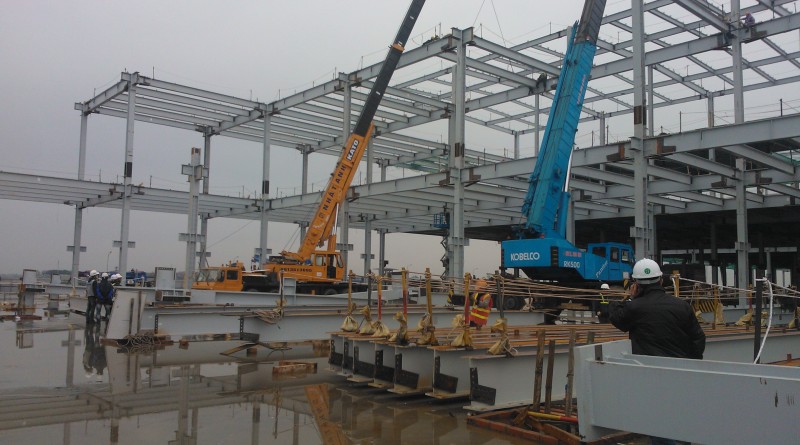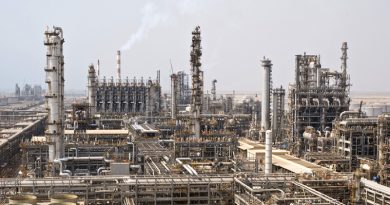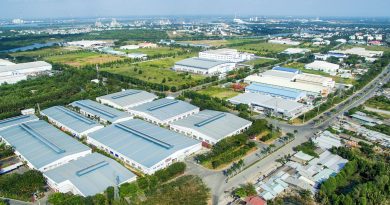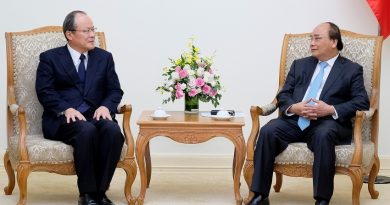Update on mega foreign invested projects in Vietnam
As of the end of January 2016, there were 20,056 foreign direct investment projects in Vietnam with a total capital sum of $280 trillion. Many multinational companies are present and continue to expand their investment in the country.
The projects are mostly industrial in nature, with the lion’s share being steel, power, and manufacturing, as well as real estate. The presence of big multinational companies, such as Intel, Samsung, Posco, and LG, indicates that Vietnam is an attractive destination due to competitive labour costs and the ever-improving business environment.
On the other hand, Vietnamese companies have been gradually increasing their capacity and product quality in order to join the global supply chain. However the connection between Vietnamese and foreign companies remains weak.
Below is the list of mega foreign direct investment (FDI) projects licensed during the 10-year period from 2006 to 2015 and their current status:
1) $1.1 billion Posco project in Ba Ria-Vung Tau
Licensed in 2006, the project aimed to build a steel plant on an area of 130 hectares. While the plant is going to operate for 48 years, producing cold and hot rolled, as well as galvanized steel items. The first phase of the plant was completed in 2009 at a cost of $340 million and now has a total capacity of 700,000 tonnes per year.
2) $1 billion Intel project in Ho Chi Minh City
Intel Corp first announced its $300 million investment for an assembly and test plant in Vietnam in 2006. The firm’s total registered investment was raised to $1 billion during the following year.
The $1 billion plant in Ho Chi Minh City went into operation in 2010. In November 2014, the company expanded the plant with an additional CPU production line.
3) $80 million Foxconn project in Vinh Phuc
The project has a registered capital of $200 million. It was licensed in 2008 with an expected start of operation in 2009. However, in July 2015 the license was revoked following the investor’s failure to complete the plant’s construction.
4) $100 million Jabil Circuit project in Ho Chi Minh City
Licensed in 2007, the project named Jabil Vietnam Ltd, invested by Jabil Circuit Singapore PTE. Ltd, is located in Saigon Hi-Tech Park on an area of 5 hectares and produces computers, as well as office, telecom, and medical equipment, consumer electronic devices, and precision plastic moulds. In July 2015, Jabil was authorised to invest another $500 million to expand the project.
5) $500 million Keangnam building in Hanoi
Licensed in 2007 and completed in 2010, Keangnam Hanoi Landmark Tower, was developed by the Vietnamese subsidiary of South Korean Keangnam Enterprises Keangnam Vina. Located on 4.6 hectares on Pham Hung Street in west Hanoi, the building is currently Vietnam’s highest building.
With a total investment capital of more than $1 billion, the 72-storey tower features a 5-star hotel, offices and apartments for lease, and two 48-storey apartment towers with a total of 922 apartments. The apartments were sold at an average price of $3,000 per square metre.
Since 2011, seven individual buyers of ten apartments in the Tower have sued Keangnam Vina, claiming that the company violated several contract terms.
The tower was recently acquired by South Korea’s AON Holdings at the price of $800 million. The sale was conducted to resolve Keangnam’s liquidity problems.
6) $9.8 billion Ca Na steel project by Vinashin-Lion in Ninh Thuan
At the time of its licensing in 2008, Malaysian company Lion Group and Vinashin’s joint venture was the biggest foreign direct investment project ever licensed in Vietnam. Construction started in November 2008, however, due to financial difficulties, progress was slow and consequently Lion Group withdrew. In 2011 Ninh Thuan province revoked the project’s investment certificate.
7) $7.9 billion Hung Nghiep Formosa steel production plant in Ha Tinh
The project was licensed in 2008 and has seen a raise to its capital to $9.9 billion in 2012.
The complex includes a steel plant with a capacity of 22 million tonne a year, a deep water port system that can accommodate 300,000 DWT ships, and a 2,100 MW thermal power plant. Upon reaching completion, Hung Nghiep Formosa is going to be the biggest steel production complex in Southeast Asia.
The first phase of the complex, which cost $10.5 billion, is expected to be completed by the end of 2016. As of October 2015, according to the Ha Tinh Department of Planning and Investment, the investor was planning to increase the capital to $28.5 billion.
8) $6.2 billion Nghi Son refinery in Thanh Hoa
Invested by four companies, namely PetroVietnam, Kuwait Petroleum International, and Japanese companies Idemitsu Kosan and Mitsui Chemicals, the refinery was licensed in 2008. With an area of 400 hectares, the refinery produces LPG, Ron 92 and 95 fuels, diesel, fuel oil, jet fuel, polypropylene, para-xylene, benzene, and sulfur.
The investors raised the capital by $2.8 billion in 2013 to make the refinery the biggest oil refinery and petrochemical project ever licensed in the country. It is scheduled to become operational in 2017 and reach its maximum annual capacity of 9.62 million cubic metres of petroleum products by 2018.
9) $4.3 billion New City project in Phu Yen
The project, licensed in 2008, is an investment of Brunei-based New City Properties Development. Occupying an area of 560 hectares, the project was supposed to include a resort, hotel, villas, bungalows, a cruise port, and various sea entertainment facilities. However, the project was coming along rather slowly.
In September 2014, the People’s Committee of Phu Yen allowed the investor to reduce the project area to 357 hectares and the investment capital to $1 billion.
Sun Rise Vietnam, a joint venture between South Korean companies Hyundai Telecom and Hwa Pyung Holding, now holds 70 per cent of the project. The remaining stakes are held by companies from China, the US, and Australia.
In June 2015, New City Vietnam Ltd held the project’s ground breaking ceremony. Local authorities expect the project to become a highlight of the province and a major tourist attraction.
10) $4.2 billion Ho Tram project in Ba Ria-Vung Tau
The Grand Ho Tram Strip Hotel was licensed in 2008, and developed by Ho Tram Project Company Ltd, majority owned by US fund Harbinger Capital Partners. The first phase of the five-star fully integrated resort opened in July 2013. This is the first resort in Vietnam with permission to operate a casino on its premises.
In December 2015, Ho Tram Project Company Ltd signed an agreement with Vietnamese company CotecCons to erect condo towers on a 164 hectare area of the project site.
11) $4.15 billion Dragon Beach tourism zone project in Quang Nam
Licensed in 2009, the 400-hectare Dragon Beach tourism zone was planned to be a haven of a beachfront hotel, an international conference centre, and a casino. At the time of licensing the zone was hoped to attract tourists to Dien Duong beach and boost Quang Nam province’s general tourism revenue, as well as to help develop its tourism scene. In 2010, the project’s investment certificate was revoked after a long pause.
12) $2 billion Nhon Trach Berjaya Dong Nai New City in Dong Nai
Licensed in 2009, the project is located on a 600 hectare site in Dongnai province, about 25 kilometres from downtown Ho Chi Minh City. It will house a theater, cultural house, square, exhibition centre, museum, administrative quarter, and commercial and social facilities such as offices, hotels, serviced apartments, food and beverage outlets, and entertainment spaces, sports centre, hospital, open green spaces and infrastructure.
Developer Berjaya Land Bhd, a subsidiary of Berjaya Corporation Berhad, stated in October 2015 that the construction of the project will begin in 2016.
13) $500 million South Tuy Hoa Creative Town project in Phu Yen
Licensed in 2009, the $11.4 billion project invested by US company Galileo Investment Group Inc. was set to build a 7,656-hectare modern township with high-tech information technology facilities, trade centers, and tourism parks. It was intended to be a lodestone to attract companies and investors to the area. Since its licensing, however, the investor have not acted to carry out the project, leading to the People’s Committee of Phu Yen revoking the investment certificate in March 2011.
14) $4 billion South Hoi An project in Quang Nam
South Hoi An project, a complex including a residential and a commercial area, a resort, and various gaming facilities, was licensed in December 2010. VinaCapital and VinaLand Limited, a closed-end fund managed by the former, planned to develop the project with Malaysian company Genting Berhad. However, in September 2012, Genting withdrew from the project, leaving VinaCapital to adjust the project plan in mid-2013, rescheduling the first phase to start operation by the end of 2015.
In September 2015, VinaCapital announced its newfound partnership with Hong Kong company Chow Tai Fook in the project. VinaCapital continued to be the strategic shareholder. Now the first phase is set to start construction in 2016.
15) $2.1 billion Mong Duong 2 thermal power plant in Quang Ninh
Licensed in 2010, Mong Duong 2 thermal power plant by AES-VCM Mong Duong Power Company Ltd.—a joint venture of The AES Corporation (USA) affiliates, Posco Energy (Korea), and China Investment Corporation (China)—, Mong Duong 2 thermal power plant is Vietnam’s first and largest thermal power plant built in the BOT (build-operate-transfer) format, with its 1,240 MW capacity.
In October 2015, the plant officially started operation. The plant produces 7.6 billion kWh of electricity per year. It is going to be transferred to the Vietnamese government after 25 years of operation, in 2040.
16) $1 billion Kobelco steel plant in Nghe An
Licensed in 2010, Japanese Kobe Steel’s plant was to operate at a capacity of 2 million tonnes per year. The raw materials for steel production would be sourced from Thach Khe iron mine in Ha Tinh and the coal used in the production process from Quang Ninh.
As of October 2015 construction of Kobelco steel plant was yet to start due to delays in the exploitation of Thach Khe mine. According to a member of the People’s Committee of Nghe An province, Kobe is working with Thach Khe Iron JSC, the owner of the mine, on a potential purchase of shares in the company. A VIR source commented that negotiations had been going on for two years now and the two parties had yet to reach an agreement.
17) $902.5 million Skybridge Dragon Sea resort project in Vung Tau
Skybridge Dragon Sea MICE project, invested by US-based Skybridge Intercontinental Development Corporation, was Ba Ria-Vung Tau province’s largest project in terms of registered capital at the time of its licensing in 2010.
As of now, the project has yet to be carried out. The delay, according to Skybridge chairman cum CEO Michael Nguyen, the land rental fees rose too high over the past few years. According to Nguyen, the rent specified by the province’s Department of Finance rose from VND325 billion ($14.6 million) in 2010 to VND1.7 billion ($76.2 million) in 2012 when the company was to start construction.
Bui Ngoc Diep, legal representative of Skybridge in Vietnam, told VIR that the company would like to start the construction in 2016 and proposed that the province apply a preferential land rental charge for the roject.
18) $2.26 billion Jaks Hai Duong thermal power plant
The 25-year BOT 2×600 MW project by Malaysian company Jaks Resources Bhd was licensed in 2011. Preliminary construction work on the project has already started, with the land clearing and boundary walls completed.
In July 2015 Jaks Resources Bhd inked agreements with China Power Engineering Consulting Group Co Ltd (CPECC) to jointly develop the plant through a 50:50 joint venture.
19) $1 billion First Solar photovoltaic panel manufacturing facility in Ho Chi Minh City
Licensed in 2011, US-based First Solar’s plant was to be developed in two phases. The first phase, with an investment value of $300 million, would have a capacity of 250MW per year and would go into operation in 2012.
However, eight months after the start of construction, the investor called a halt, due to the global demand and supply imbalance for solar power panels. In 2014, the company was reported to have finished all legal procedures to sell its assets in Vietnam.
20) $452.38 million S-Telecom mobile service project
Licensed in 2001 by a consortium including South Korean wireless telecommunications operator SK Telecom, the project aimed to provide CDMA services in Vietnam.
At its peak, S-Telecom had 3.1 million users. The company was also the first in Vietnam to provide 3G services. In 2012, as business took a plunge due to heavy competition, S-Telecom withdrew from the country, leaving behind its antennae on the roofs of many residential houses. The company previously paid homeowners to install these antennae.
21) $1.2 billion Tokyu Binh Duong New City
Licensed in 2012, Tokyu Binh Duong New City is a 1,000-hectare industry-service-urban complex in Binh Duong, invested by Becamex Tokyu Ltd—a joint venture between Vietnamese company Becamex IDC Corporation and Japanese company Tokyu Corporation.
Binh Duong authorities estimated that total investment into the complex is going to exceed VND150 trillion ($6.7 billion) by 2020. Many domestic and foreign investors have built high-rise buildings and carried out low-price commercial housing projects in the province, but sales fall below expectations.
22) $574.8 million Bridgestone radial tyre manufacturing plant in Haiphong
Licensed in 2012, the plant invested by Japanese tyre manufacturer Bridgestone started operation in October 2014. Currently, the plant boasts a capacity of 6,000 tyres a day. As of January 2016, in a meeting with Haiphong authorities, leaders of the company talked about the prospect of expansion and about selling its products in Vietnam instead of producing purely for export.
23) $2.018 billion Vinh Tan 1 thermal power plant in Binh Thuan
Licensed in 2013, the BOT plant is an investment of a consortium of two Chinese companies and Vietnam National Coal – Mineral Industries Holding Corporation Ltd (Vinacomin). The plant is part of Vinh Tan Thermal Power Complex, which consists of four projects with a total capacity of 5,600 MW. This is the country’s largest coal-fired thermal power plant.
While Vinh Tan 1, 3, and 4 remain under construction, Vinh Tan thermal plant 2 has started operation in January 2014.
The operation of the plant sparked strong opposition from residents in the surrounding area on account of possible/potential pollution hazards. Due to strong coastal winds, Vinh Tan thermal plant 2 is obscured by fumes and dust, despite efforts to regularly irrigate/water the area, as required by local authorities.
In April last year, thousands of people blockaded National Highway No 1A, stopping traffic for hours to complain about coal dust and cinder from the power complex, especially the newly built Vinh Tan No 2.
The Binh Thuan People’s Committee urged the power complex management board to stop all executive work in case wind speed surges to level 8 and 9 (60 to 88 km per hour).
24) $2 billion Samsung Electronics Vietnam Thai Nguyen
Licensed in 2013, Samsung Electronics’ Vietnam Thai Nguyen plant started operation in 2014, employing 5,000 workers and producing two million products per year. The project has helped Thai Nguyen attract investment from Samsung’s multitude of suppliers, too.
25) $1.5 billion LG Electronics Haiphong Campus
The project was licensed in 2013 and as soon as March 2015, LG Electronics opened the main facility of the project. The 800,000-square-metre facility will house production lines to manufacture TVs, mobile phones, washing machines, air conditioners, and car infotainment systems for both the domestic and overseas markets.
26) $1 billion Bus Industrial Center in Binh Dinh
Russian investor Bus Industrial Center Ltd’s project was licensed in 2013, with a view to build a factory to produce spare parts for buses and provide related services.
As of now, the project is stuck at a standstill.
27) $3 billion Samsung Thai Nguyen phase II
In 2014, Samsung received the license to invest $3 billion into the second phase of Samsung Electronics Vietnam Thai Nguyen plant (SEVT 2), raising the facility’s total investment capital to $6.5 billion. SEVT 2 was designed with a capacity of 10 million products per month and to employ 30,000 workers.
28) $1.4 billion Samsung CE Complex Ho Chi Minh City
Licensed in October 2014, construction of Samsung’s Ho Chi Minh City complex started in May 2015 on a 70 hectare area of Saigon Hi-tech Park (SHTP). The complex is expected to come into operation in February 2016. SHTP has recently granted investment licences to several projects worth more than $120 million that will produce components for the complex.
In December 2015, Samsung was endowed with an investment certificate to expand the project by $600 million, bringing the complex’s total investment value to $2 billion.
Samsung will set up a research and development centre for audiovisual devices and provide guarantee services at SHTP.
29) $1.25 billion Phoenix Beach project by Dewan International in Khanh Hoa
The project was licensed in 2014 by Dewan International, a Hongkong-based subsidiary of Indian real estate developer Dewan Group. The project design includes a 42-floor five star hotel to be built on 74.16 hectares of land and water surface.
In September 2015, the project investment certificate was revoked by the People’s Committee of Khanh Hoa province on the basis of the investor’s failure to supply the registered capital according to schedule.
30) $1 billion Samsung Display Bac Ninh project
Licensed in 2014, Samsung Display project, which produces screens for mobile phones, started operation in March 2015. The project aims to supply the two Samsung plants in Bac Ninh and Thai Nguyen with screens and has capacity of 48 million products per year. In August 2015 Samsung increased the project’s total investment volume by an additional $3 billion.
31) $2.018 billion Duyen Hai 2 thermal power plant in Tra Vinh
Licensed in 2015 by Malaysian Janakuasa (Malaysia), Duyen Hai 2 thermal power project is going to be built in a BOT format.
The project has two turbines with a total capacity of 1,200 MW. Construction is going to start in the second quarter of 2016.
The plant, which is expected to go on stream before 2020, will be one of the four thermal power plants in Duyen Hai Power Centre. The remaining plants, representing a $6 billion investment by the Electricity of Vietnam Group (EVN), are Duyen Hai 1, Duyen Hai 3, and Duyen Hai 3 extension.
Once completed, the power centre will contribute to the national power grid an additional capacity of 30 billion kWh annually.
32) $1.2 billion Empire City in Ho Chi Minh City
The developer is a joint venture of Tien Phuoc Real Estate JSC, Tran Thai Real Estate JSC, and UK-based Denver Power Ltd—a subsidiary of multinational financial company Gaw Capital Partners—with the two Vietnamese companies contributing 50 per cent of the capital.
Licensed in 2015, the project is expected to be completed in 2022. Occupying a 14.5-hectare area on the bank of the Saigon River, the project is going to include a trade centre, a five-star hotel, office space and apartments, and a multifunctional building of 86 floors.
Construction started in October 2015.
33) $1 billion Cheng Loong Binh Duong packaging plant
In December 2015, Taiwanese industrial paper producer Cheng Loong received the investment certificate to build its $1 billion packaging factory in the southern province of Binh Duong.
The plant is going to be built on an 80-hectare land plot in Ascendas Protrade Singapore Tech Park and will have the capacity to push out one million tonnes of industrial paper and consumer paper products per year.
Cheng Loong currently has 29 plants all around the world, providing supply packaging to big companies, such as Apple and Nike. The Vietnamese plant is Cheng Loong’s biggest ever, according to the company’s president Tsai Tong Ho.
Source: Vir







